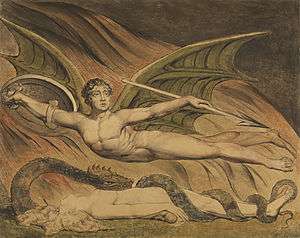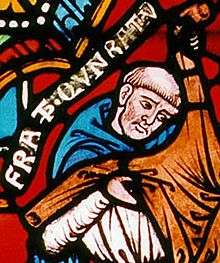Vox in Rama

Vox in Rama (Latin: A voice in Rama) is a papal bull issued by Pope Gregory IX in either 1232, 1233 or 1234 condemning a German heresy known as Luciferian, a form of devil worship.[1] The bull was issued to King Henry, son of Emperor Frederick II, in June 1233 and subsequently to Archbishop Siegfried III of Mainz demanding they use all efforts to stop the practice.
Background

The 12th century was a time of great superstition and saw the start of the "demonisation of heretics"[2] by the Church, attributing their lack of belief in the Catholic faith to the devil. Barber claims that it was during this time that there was a great zeal for the sending out of inquisitors by the pope and local bishops with the aim of seeking out potential heretics.[3] In 1233, Konrad von Marburg began an inquisition in Mainz at the behest of either the Pope or the archbishop.[4]
Through alleged torture and terror, Conrad reported he had uncovered a satanic cult who worshiped both the devil himself and a diabolical black cat.[5] The inquisition of Conrad was controversial: shortly after Conrad arrived in Mainz, a papal official called Bernard wrote to Gregory stating that Conrad had been forcing innocent people to confess by threatening them with burning at the stake if they refused to do so.[6]
The issue of the bull was a response to Conrad's allegations, urging Siegfried III and King Henry, representing the ecclesiastical and temporal authorities respectively, to seek out and destroy the heretics.[4]
Contents
Although some controversy exists over its authenticity, the text was quoted extensively in Malcolm Lambert's historical study The Cathars.[7][note 1]
The bull describes in detail the initiation rites of the sect, claiming that the potential initiate is first approached by a mysterious toad as large as a dog.[8] Shortly afterwards an emaciated pale man would appear, whom the initiate would kiss and thereby forget all memory of the Catholic faith.[6] Members of the sect would then meet for a meal.[8] When the meal had ended, the sect would arise and a statue of a black cat would come to life, walking backwards with its tail erect.[3] First the new initiate and then the master of the sect would kiss the cat on the buttocks.[4]
After the ritual was completed, the bull claims that the candles in the room would be extinguished and the sect would engage in wild orgies which were sometimes homosexual in nature. Once the candles are re-lit, a man from a dark corner of the room “comes forth from the loins upward, shining like the sun. His lower part is shaggy like a cat.”[7] After a brief litany-like dialogue between the cat and the cult members, the meeting ends.[7]
Gregory also claims that the sect committed various crimes against the Eucharist:
They even receive the body of the Lord every year at Easter from the hand of the priest and, carrying it in their mouths home, they throw it into the latrine in contempt of the Saviour.[7]
In conclusion, Gregory condemns the practice and calls upon the religious and secular authorities in the diocese to take action against the cult's participants.[8]
Vilification of black cats
Some historians have claimed that Vox in Rama is the first official church document that condemns the black cat as an incarnation of Satan. In the bull the cat is addressed as “master” and the incarnate devil is half-man half-feline in nature. Engels claims that Vox in Rama was “a death warrant for the animal, which would be continued to be slaughtered without mercy until the early 19th century.” It is said that very few all-black cats survive in western Europe as a result.[5]
See also
Notes and references
Notes
References
- ↑ Jennifer Kolpacoff Deane (2011). A History of Medieval Heresy and Inquisition. Rowman & Littlefield Publishers. p. 197. ISBN 978-0-7425-6811-2.
- ↑ Kors, Alan Charles, ed. (2000). "IV: Popes, Theologians, Preachers, Lawyers and Judges". Witchcraft in Europe, 400-1700: A Documentary History (2 ed.). University of Pennsylvania Press. p. 114. ISBN 0812217519.
- 1 2 Barber, Malcolm (2006). "10: Conclusion". The Trial of the Templars (2 ed.). Cambridge University Press. p. 114. ISBN 0521672368.
- 1 2 3 Barber, Malcolm (1973). "Propaganda in the Middle Ages". Nottingham Mediæval Studies. 17: 42–57.
- 1 2 Engles, Donald W. (2001). "Appendix III: Pope Gregory and the Vox in Rama". Classical Cats: The Rise and Fall of the Sacred Cat. Routledge. p. 183. ISBN 0415261627.
- 1 2 3 Russell, Jeffery Burton (1984). "Antinomianism, Scholasticism, and the Inquisition". Witchcraft in the Middle Ages. Cornell University Press. p. 160. ISBN 0801492890.
- 1 2 3 4 Gregory IX (1883). "XIII: Vox in Rama". In Rodenberg, K. Epistolæ sæculi. p. 537.
- 1 2 3 Lambert, Malcolm D. (1998). The Cathars. Wiley-Blackwell. ISBN 063120959X.